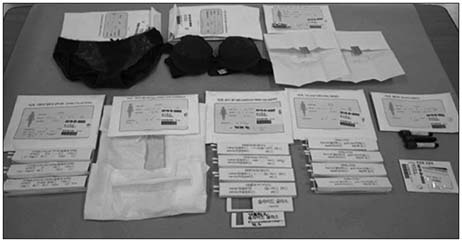J Korean Neuropsychiatr Assoc.
2019 Nov;58(4):284-290. 10.4306/jknpa.2019.58.4.284.
The Review of Victims of Violence from the Perspective of Physical Injury
- Affiliations
-
- 1Department of Obstetrics and Gynecology, Kangwon National University School of Medicine, Chuncheon, Korea. babysaver73@gmail.com
- KMID: 2465048
- DOI: http://doi.org/10.4306/jknpa.2019.58.4.284
Abstract
- Violence against socially vulnerable victims such as that associated with child abuse, domestic violence, and sexual assault has become a considerable problem in Korean society. Government resources have been invested in establishing effective response systems that can minimize the damage by identifying the causes of violence-related incidents, preventing them, and correcting the underlying problems. The starting point for such solutions is to recognize an incidence involving violence. Because victims do not tend to reveal incidents voluntarily, the ability of health care providers to recognize victims of violence is important. In the case of domestic violence, a victim who comes to the hospital while hiding the actual situation may have suffered more serious physical injuries than reported. A screening tool for child abuse has been developed to distinguish survivors of abuse among children who have come to the emergency room due to trauma. In addition, sexual abuse forensic emergency medical kits have been developed since 2002 and have been put into practice. One-stop service centers and "˜Sunflower' Centers can support violence-related health care more systematically than that provided by other means.
MeSH Terms
Figure
Reference
-
1. Ministry of Health and Welfare, National Child Protection Agency. Child Abuse & Neglect Korea 2018. Sejong: Ministry of Health and Welfare;2018.2. Louwers EC, Korfage IJ, Affourtit MJ, Scheewe DJ, van de Merwe MH, Vooijs-Moulaert FA, et al. Detection of child abuse in emergency departments: a multi-centre study. Arch Dis Child. 2011; 96:422–425.
Article3. Flaherty EG, Sege R. Barriers to physician identification and reporting of child abuse. Pediatr Ann. 2005; 34:349–356.
Article4. Paek SH, Jung JH, Kwak YH, Kim DK, Ryu JM, Noh H, et al. Development of screening tool for child abuse in the Korean emergency department: using modified Delphi study. Medicine (Baltimore). 2018; 97:e13724.5. Skellern CY, Wood DO, Murphy A, Crawford M. Non-accidental fractures in infants: risk of further abuse. J Paediatr Child Health. 2000; 36:590–592.
Article6. Christian CW. The evaluation of suspected child physical abuse. Pediatrics. 2015; 135:e1337–e1354.
Article7. Kellogg N. Oral and dental aspects of child abuse and neglect. Pediatrics. 2005; 116:1565–1568.
Article8. Dunstan FD, Guildea ZE, Kontos K, Kemp AM, Sibert JR. A scoring system for bruise patterns: a tool for identifying abuse. Arch Dis Child. 2002; 86:330–333.
Article9. Kairys SW, Alexander RC, Block RW, Everett VD, Hymel KP, Johnson CF. Oral and dental aspects of child abuse and neglect: joint statement of the American Academy of Pediatrics and the American Academy of Pediatric Dentistry. Pediatrics. 1999; 104:348–350.10. Andronicus M, Oates RK, Peat J, Spalding S, Martin H. Non-accidental burns in children. Burns. 1998; 24:552–558.
Article11. Kocher MS, Kasser JR. Orthopaedic aspects of child abuse. J Am Acad Orthop Surg. 2000; 8:10–20.
Article12. Eisenstat SA, Bancroft L. Domestic violence. N Engl J Med. 1999; 341:886–892.
Article13. Park CW, Lee SH, Choi DY, Yang HY. Victimization characteristics and severity of physical injury by domestic violence. Korean J Fam Pract. 2018; 8:244–251.
Article14. Statistics Korea. Korean social trends 2018. cited 2019 Aug 22. Available from: http://kostat.go.kr/sri/srikor/srikor_pbl/3/index.board?bmode=download&aSeq=372043&sort=1.15. Holmes MM, Resnick HS, Kilpatrick DG, Best CL. Rape-related pregnancy: estimates and descriptive characteristics from a national sample of women. Am J Obstet Gynecol. 1996; 175:320–324.
Article16. Sugar NF, Fine DN, Eckert LO. Physical injury after sexual assault: findings of a large case series. Am J Obstet Gynecol. 2004; 190:71–76.
Article17. Riggs N, Houry D, Long G, Markovchick V, Feldhaus KM. Analysis of 1,076 cases of sexual assault. Ann Emerg Med. 2000; 35:358–362.
Article18. Kim SK, Park YK, Kang YD. Analysis of sexual assault victims: based on data from a one-stop service center in Chungcheongnam-do. Korean J Obstet Gynecol. 2012; 55:736–744.
Article19. Larsen ML, Hilden M, Lidegaard Ø. Sexual assault: a descriptive study of 2500 female victims over a 10-year period. BJOG. 2015; 122:577–584.
Article20. Berkoff MC, Zolotor AJ, Makoroff KL, Thackeray JD, Shapiro RA, Runyan DK. Has this prepubertal girl been sexually abused. JAMA. 2008; 300:2779–2792.
Article21. Workowski KA, Bolan GA. Sexually Transmitted Diseases Treatment Guidelines, 2015. MMWR Morb Mortal Wkly Rep. 2015; 64:1–138.22. Adlington R, Browne R. Management of patients seen post-sexual assault at a North London inner city genitourinary medicine clinic 2005-2008. Int J STD AIDS. 2011; 22:286–287.
Article23. Jo S, Shin J, Song KJ, Kim JJ, Hwang KR, Bhally H. Prevalence and correlated factors of sexually transmitted diseases-chlamydia, Neisseria, cytomegalovirus--in female rape victims. J Sex Med. 2011; 8:2317–2326.
Article24. World Health Organization. Guidelines for medico-legal care for victims of sexual violence. Geneva: World Health Organization;2003.25. Kim SK, Lee MY, Choi SJ, Ahn TG, Seo JA, Jeong HY. Analysis of sexual assault victims. Korean J Obstet Gynecol. 2011; 54:37–42.
Article26. Committee on Health Care for Underserved Women. ACOG Committee Opinion no. 592: sexual assault. Obstet Gynecol. 2014; 123:905–909.27. McNamee KM, Dawood F, Farquharson RG. Mid-trimester pregnancy loss. Obstet Gynecol Clin North Am. 2014; 41:87–102.
Article28. National Assembly of South Korea. How can we support pregnant victims of sexual violence? cited 2019 Aug 22. Available from: https://dl.nanet.go.kr/SearchDetailView.do?cn=PAMP1000037851.
- Full Text Links
- Actions
-
Cited
- CITED
-
- Close
- Share
- Similar articles
-
- Problem of sexual violence in the medical system and plans for improvement from a legal perspective
- Experiencing Coercive Control in Female Victims of Dating Violence
- Domestic Violence: Evaluation and Prevention of Medical Sequelae of Victims
- Family Violence: Psychiatric Aspects
- Clinical Analysis of Domestic Violence in Emergency Department


